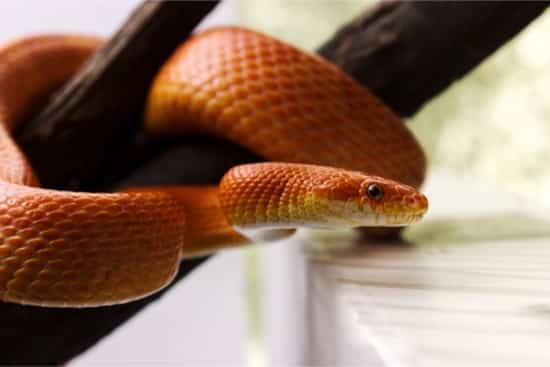Snakes are interesting and colorful animals that have become very popular as pets in recent years. The most common pet snakes are found in the Pythonidae, Colubridae, and Boidae families.
Ball pythons are by far the most popular pet snakes, closely followed by corn snakes. These snakes are easy to handle and care for in captivity.
There are over 3000 species of snakes on the planet, however, most are hard to manage and don’t make particularly good pets. We’ll take a look at the types of snakes that make the best pets.
What are the Most Common Pet Snakes for Beginners?
The snakes that make the most suitable pets have the following qualities:
- They aren’t too heavy-bodied or a threat to the keeper
- They are non-venomous
- They are non-aggressive and don’t bite very often
- They don’t have complex temperature or humidity needs
1) Ball Pythons (Python Regius)

Ball pythons (also known as royal pythons) are a popular choice for first-time snake owners. They’re easier to handle than other species, becoming tamer the more they become used to your touch.
Ball pythons usually don’t grow more than three to five feet. This makes them smaller than many other constricting snakes which are kept as pets.
There are hundreds of ball python morphs. This refers to the different colors/patterns. The rarer the specimen, the more expensive the morph.
Behavior and Temperament
Ball pythons are also so-called because they roll themselves into a ball when frightened, tucking their heads inside their coils. They are nocturnal and solitary, preferring to hide during the day and come out at night.
You may notice a ball python flicking its tongue while moving about. This is its way of learning about its surroundings. In rare cases, like all snakes, a ball python may bite if it feels threatened.
Caring for Ball Pythons
Ball pythons are easier to take care of than many other pet snakes. They need humidity in their environment. They should be housed in a wooden enclosure of at least 34″ in length, with a basking temperature of between 85 oF-88oF.
Ball pythons are carnivores and should have a diet comprising of pre-killed prey. While they’re young, they will only be able to eat pinkies or rat pups. As they grow, you can start to offer both rats and mice.
Here’s our complete guide to ball pythons as pets.
2) Corn Snakes (Pantherophis Guttatus)
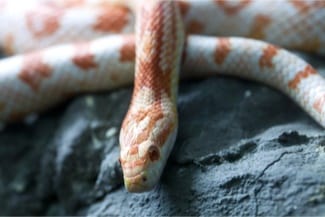
Corn snakes are popular as pets due to their calm and docile nature and a vast range of beautiful colors and patterns. With most of them having bright orange backs with a black and white pattern, they’re easy to identify.
Corn snakes are relatively small compared to other snakes, hatching at eight to 12 inches long, and reaching four to five feet in length. Their size makes them easy to handle, even for beginners.
Behavior and Temperament
Corns snakes are non-aggressive, making them ideal as pets. They can tolerate being handled regularly and they’re not prone to biting or constricting, but can bite when under stress. However, if you notice your corn snake hissing, it’s a sign they feel threatened.
These are active, inquisitive, and generally placid, although they do require periods of solitude, particularly after feeding. They seem to be indifferent to being handling, however, it’s best to avoid doing so for two to three days after feeding them to prevent regurgitation.
Caring for Corn Snakes
Corn snakes are easy to care for, with most adults requiring only a 20 to 25-gallon vivarium. They enjoy hiding, so make sure you include two hides and add some Aspen shavings to the bottom of the enclosure.
Mice are the most common food for corn snakes. However, you can also feed them other prey such as rats or quails. Make sure the prey is no more than the width of the widest part of the snake’s body.
Here’s our complete guide to corn snakes as pets.
3) Boa Constrictors (Red-Tailed Boa)
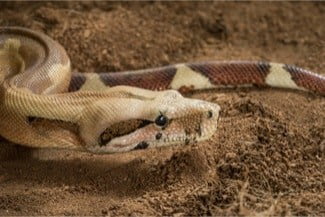
Boa Constrictors can make great, low-maintenance pets. They’re usually very alert and tolerate being handled regularly. Depending on the habitat they’re attempting to blend into, their bodies can be green, tan, yellow, or red in color.
Boas range in size, sometimes reaching 10 feet in length. They never actually stop growing – their growth rate simply slows down once they reach adulthood. These snakes often live to 25-30 years with the proper care, making them a big commitment for their owners.
Despite their longevity, boas are susceptible to a viral condition called Inclusion Body Disease (IBD), according to the Veterinary Record.
Behavior and Temperament
Boa constrictors are not generally considered aggressive pets and, with regular handling, they usually become very tame. However, despite their docile temperament, they may hiss or bite when they feel threatened.
Boas are well-known for having more “personality” than other snakes, seeming more curious about their surroundings.
Boas are nocturnal creatures, although they will occasionally come out during the day to sun themselves in warmer temperatures.
Caring for Boa Constrictors
Proper care is a vital factor in a boa constrictor’s lifespan. It’s important to provide sufficient space, suitable food items, and the right temperatures and humidity to keep them happy and healthy.
Boa constrictors originate from tropical climates, so their cages must be warm enough. During the day, the temperature should be between 82 to 90°F (28-32°C). A basking spot of 90 to 95°F (32 to 35°C) should also be provided. Use accurate thermometers in several areas of the snake’s cage.
In the wild, boa constrictors eat a wide variety of small animals, including bats, birds, rats, and squirrels. However, when kept as pets, it’s best to feed them rodents which have been thoroughly thawed to room temperature. Generally, boas prefer to hide with their prey before they eat it.
Here’s our complete care guide for boa constrictors.
4) California Kingsnake (Lampropeltis Getula Californiae)
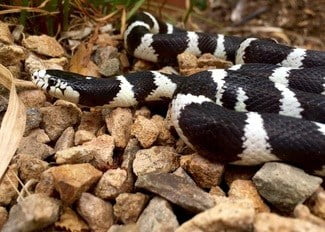
Belonging to the Colubridae family, California Kingsnakes are a good choice for people who like their pets on the feistier side.
You’ll need a bit more experience to manage this snake, particularly as they can become anxious. They come in attractive colors and patterns and can grow up to four feet in length. California kingsnakes and milk snakes, which belong to the same family of snakes, are sometimes confused.
Behavior and Temperament
While California Kingsnakes are better tempered than similarly-sized snakes, they can become jumpy. They generally don’t become aggressive unless they’re agitated. If they roll into a ball, hiss, or vibrate their tail quickly, that’s a sign they’re stressed.
Although California Kingsnakes can be feisty, they’re not dangerous to humans. They’re small in size too, making them easier to maintain and handle than many other pet snakes.
Caring for California Kingsnakes
California Kingsnakes should be housed in a 20-gallon enclosure, ideally with a screen top. They like to hide and burrow, so it’s a good idea to add two or three hides. While these pet snakes don’t need any special lighting, tank heaters can help them during the thermoregulation process.
California Kingsnakes will eat just about anything in the wild. However, as pets, it’s best to feed them rodents, such as mice, which are readily available. You can give them live reptile food or thawed frozen mice.
Here’s our complete guide to caring for California kingsnakes.
5) Green Tree Python (Morelia Viridis)
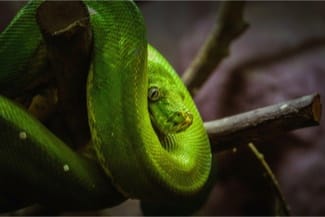
Originating in Australia and New Guinea, green tree pythons are beautiful snakes that are well-known for their unique and diverse colors. Young snakes are usually yellow or red and change to bright green as they mature. Some keep their bright yellow colors while others turn straight to blue.
The slender green tree python can often appear smaller than it is, which is largely due to its habit of perching on a branch in a compact looped posture. In fact, adults average four to five feet in length, sometimes exceeding six feet.
Most green tree pythons live into their teens, with a few making it into their mid-20s. This snake species is more fragile than most, however, with the proper care and supplies, they should enjoy a healthy life in captivity.
Behavior and Temperament
While green tree pythons are known to have an “attitude problem”, they can make good pets for more experienced keepers. They’re docile, however, they can be aggressive when handled. They’re not a good choice for beginners, and you should have experience caring for snakes before you think about owning a green tree python.
These snakes aren’t very comfortable with a person unless they’ve known them for a long time. Even then, you may get on the wrong side of them if you don’t handle them correctly.
Caring for Green Tree Pythons
They are arboreal creatures, and so their enclosures should contain strong branches or perches set at various heights. This will provide a stimulating and enriching environment for them. The snake will rest on its branch during the day and explore its cage at night.
Green trees originate from the rainforest, so they need a fairly warm and humid environment. Make sure one side of the enclosure has a basking spot with a temperature of between 86-88°F, and the other at a cooler 78-80°F. This will help them control their body temperature during thermoregulation.
Here’s our complete guide to green tree python care.
6) Rosy Boa (Lichanura Trivirgata)
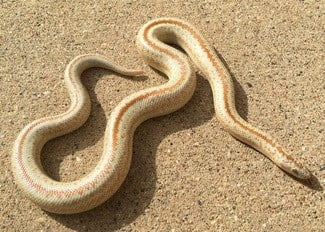
Rosy boa snakes are popular as pets due to their smaller size and passive temperament. Like many other snake species, they’re available in a wide range of color patterns (morphs).
The rosy boa is one of the smallest boa constrictors, rarely growing longer than three feet. They can occasionally reach four feet, but this is rare. They usually live for 25 years or more when kept in captivity as pets.
Behavior and Temperament
Rosy boas are timid, yet very inquisitive. As well as loving to explore, they also enjoy human contact. Once a bond has been established with their keeper, they’ll love crawling playfully up and down their arms. However, it’s important to keep in mind that they can become overwhelmed and stressed out if they’re not handled responsibly.
The rosy boa is one of the slowest-moving snake species in the world. In the wild, they’re unable to catch their prey and must lie in ambush to find their meals. They like to have several ‘hide boxes’ because they want to feel protected from predators.
Caring for Rosy Boas
Rosy boas are well-known for seeking escape routes when kept as pets, and so it’s best to keep them in an enclosure that remains highly secure. A 20-gallon tank will be big enough, however, it’s a good idea to avoid a screen top as this can scratch their noses. Hatchlings can be kept in small shoeboxes or tiny cages.
Rosy boas thrive in arid, rocky environments, spending most of their time escaping the heat by hiding under the ground or inside crevices. They’re also very adept burrowers and like to be able to dig around a loose substrate inside their enclosures.
Good substrates are aspen reptile bedding and reptile sand. While rosy boas don’t require any special lighting, they do need a heat source to help them during thermoregulation. An under-tank heat pad is a good option for keeping their bellies warm and aiding digestion.
Here’s our complete guide to Rosy Boa care.
7) Gopher Snake (Pituophis Catenifer)
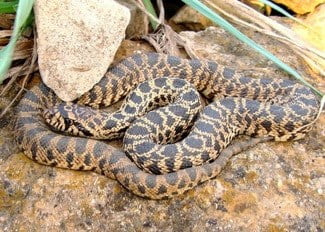
Non-aggressive and easy to care for, gopher snakes can be very good pets for beginners. They’re among the most common snake species in America.
However, you should never capture a wild snake and keep it as a pet. This is because gopher snakes caught in the wild often have temperament and health problems. Go to a trusted dealer instead and buy a captive-bred snake.
Gopher snakes are heavy-bodied, measuring around a foot in length when they hatch. Adults grow to four to five feet on average, although large snakes (especially bulls), may reach six feet. Gophers live to an approximate age of 15 years; however, some have been known to live to 30 years old. Gopher snakes are mistaken for rattlesnakes in the wild.
Behavior and Temperament
Gopher snakes can sometimes be intimidating because of their impressive size. However, there’s little to fear because they’re non-venomous. They don’t have venom glands and aren’t aggressive, only biting humans when frightened. They may hiss and strike with their mouth closed when threatened but this is rare.
Gopher snakes are docile and gentle, as long as you treat them well. Work out what makes your snake feel nervous or threatened and avoid this behavior. In time, they will understand that you won’t harm them and become less defensive.
Caring for Gopher Snakes
Gopher snakes are easy to care for, with juveniles requiring a 20-gallon enclosure and a then 30-gallon enclosure when they mature. These snakes are skilled escape artists, so it’s important that their housing is very secure. A well-fitting screen lid is vital.
Gopher snakes eat gophers (hence their name) and small rodents in the wild. When in captivity, you can feed them pinkies when they’re young and then larger rodents as they grow. Pinkies are small mice about an inch in length that can be frozen and then thawed.
This snake species has grown accustomed to chasing animals down burrows to catch their prey. Therefore, they naturally prefer a loose substrate a couple of inches deep in their enclosure.
Here’s our complete guide to gopher snake care.
8) Western Hognose Snakes (Heterodon Nasicus)
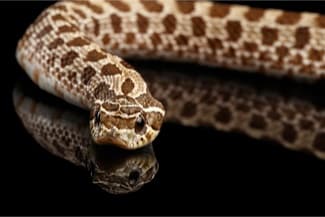
Found in America, South America, and Madagascar, Western hognose snakes have become very popular as pets. They only grow up to approximately 24” in length and have a good temperament. This species is perfect for first-time snake owners as well as more experienced keepers.
Visually, there are a few things that make the Western hognoses stand out against other snakes. As well as having a distinct upturned nose and a hood like a cobra, they have rear fangs which they use to keep hold of their prey. They are tan, brown, olive or grey in color and have glossy black scales on their undersides. There are very few hognose snake morphs.
Behavior and Temperament
Western hognoses are very unlikely to bite, and even in the wild, they use bluffing methods to fend off threats. The snake will take a huge breath and inflate its body before releasing a loud hissing noise. It may strike its intruder, however, it’s mouth will remain closed. Sometimes they even play dead as a defense mechanism.
Western hognoses are one of the least aggressive snakes in the world, usually remaining passive and calm when handled. Plus, they stay a manageable size, making them ideal for new or young keepers.
Caring for Western Hognose Snakes
Docile and non-aggressive, Western hognose snakes are among the easiest snakes to look after. But although they’re timid, they’re unique and have distinct housing, feeding, and sanitation needs.
These snakes need room to move, however, too much space can make them feel anxious. Start with a 10-gallon tank while your snake is young and move to a 20-30-gallon tank once it reaches adulthood.
Western hognoses aren’t skilled climbers and are unlikely to escape, however, you still need to make sure the tank remains secure. The tank should include a warm and cool side for temperature regulation, a suitable substrate, a hide, and a water bowl.
Here’s our complete guide to caring for hognose snakes.
9) Rat Snakes (Pantherophis Obsoletus)
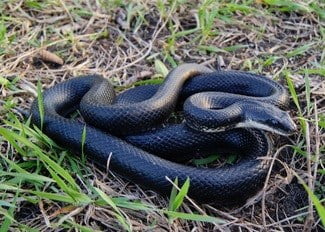
Rat snakes are non-venomous and kill prey by constriction. Found throughout the Northern Hemisphere in Canada and the USA, they make good pets. Not only are they easy to care for, but they have a mild temperament, being very tolerant of human handling.
Most rat snakes are medium to large, growing up to five feet in length. Although some can grow up to eight feet long, those kept as pets tend to be smaller. Pet rat snakes have a long lifespan, living for up to 30 years.
Behavior and Temperament
Rat snakes are sometimes mistaken for rattlesnakes. However, these snakes are non-venomous and calm and docile when handled correctly and regularly. If they’re feeling threatened, black rat snakes may release a “musk” odor to repel a predator.
Rat snakes are multitalented, being skilled climbers, and they can even swim when necessary. Their smaller size and non-aggressive nature make rat snakes popular as pets, both with beginners and experienced keepers.
Caring for Rat Snakes
Rat snakes can be easy to care for, largely because they don’t require much maintenance once their cage is set up. They’re resilient snakes and your main duties besides feeding them will be cleaning their cage when necessary and making sure their water bowl is kept clean.
When choosing an enclosure for your rat snake, keep in mind that they’re excellent climbers. An extra secure tank is required to make sure they stay in their home.
Add a substrate to the tank to allow for hiding and burrowing. In the wild, rat snakes often reside in heavily wooded places, so it’s a good idea to choose a substrate that reflects this environment.
Here’s our complete guide to caring for rat snakes as pets.
10) Garter Snake (Thamnophis)
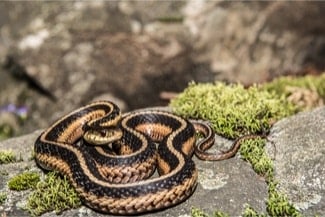
Garter snakes are smaller than many other snake species, averaging approximately three feet in length for females and two feet for males. Their smaller size makes them easier to handle than many other pet snakes.
The average life span of a garter snake in the wild is only four to five years, however, this figure doubles when they’re in captivity. Pet snakes can easily reach over 10 years old, particularly when they’re cared for properly and the right snake supplies are used.
Behavior and Temperament
Garters tend to have a gentle and docile temperament, making them popular as pets. Most of them won’t bite, instead opting to spray a musk smell when they feel threatened. In the rare event that your garter snake nips you, don’t worry – their venom can’t harm humans. It’s just used to demobilize prey, such as small toads.
One of the reasons that garter snakes are such popular pets is that they’re ideal for children to hold, as long as they’re supervised by an adult and don’t squeeze them too tightly. They’re relatively small snakes and they’re active during the day too.
Caring for Garter Snakes
Garter snakes are easy to care for, however, it’s important to keep in mind that they’re always primed for escape. They can crawl through openings that seem too small for them, grasping any opportunity to flee. You need to make sure their enclosure is secure, with its lid fitting tightly and firmly.
Garter snakes are very active, spending hours every day exploring their habit. Provide lots of climbing opportunities to give your snake stimulation and use hides to help it feel more secure.
Substrates should also be chosen carefully. Garters enjoy burrowing (and defecate frequently), so make sure you choose a substrate carefully.
Here’s our complete guide to caring for garter snakes as pets.
We’ve looked at America’s most popular snakes, so they all make good beginner pets. You won’t go too far wrong with a ball python or a corn snake. They’re beautiful pet snakes with friendly temperaments.

